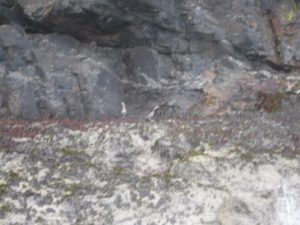Summertime and the sea’s warmed up, the seals are gathering for mating season, the razorbills and guillemots have flown out to sea and there’s an abundance of oyster catchers, cormorants and shags to see, there’s even an occasional kingfisher and some wild seagulls – you’re chips are safe with these guys as they live off fish in the sea!
The St Agnes Coastline with dramatic cliffs and colourful rocks carved out during the Cornish Mining Era stay the same throughout the seasons, but the wildlife changes.
On our St Agnes Koru Kayak Adventures are home to some wonderful wildlife.
Grey Seals
North Atlantic Grey Seals are thriving as this time of year. Their numbers swell in summer during mating season and we have definitely noticed an increase in numbers over the past few weeks. Lots of lovely juveniles all curious and swimming alongside the kayaks.
Atlantic grey seals are bulky and slow on the land, but are long distance swimmers who have been known to swim as far as Ireland and Wales according to records kept by Cornwall Seal Group.
It’s always important to give seals space, but they are naturally curious animals who will often pop up around the kayaks to say hello or can be seen bobbing along in the sea having a snooze.
Seals can weigh up to 300kg, that’s a whole lot of fish, and can give live for 3-40 years so every year we look forward to seeing Silverback and Maggie!

Atlantic Grey seals, St Agnes Coastline, Cornwall
Shags and Cormorants

Is it a Cormorant or a shag? Both are black birds who like to swoop down and swim under water to catch fish. Both have long necks but shags are smaller and have a steep forehead, but shags are smaller coastal birds who can be seen perched on the rocks drying off their wings before their next fishing dive. They can dive up to 45 metres! The rock outlets are teaming with them over the summer and you can often see them with their wings spread out drying them out after diving in the sea for fish.
Oyster Catchers
The oyster catchers all tend to live around the min waterfall just before Gadger and cluster together on a rock. You can hear their shriek calling sound as they fly by. Their bright red beaks stand out again their black and white feathers. Despite being called Oyster Catchers, their main food is cockles and mussels on the coast and their long beaks perfect for eating them. On the St Agnes Coastline there’s an abundance of small mussels clinging onto the rock faces of Gadger.

Oystercatchers, St Agnes Coastline, Cornwall
Peregrine Falcons, Dolphins and Basking Sharks have all been spotted on our kayak adventures over the years, so if you are lucky you might spot one of those aswell!

Sunfish
Sunfish
Sunfish can be quite tricky to spot. You will probably see their flapping fin before you see their whole body unless you are right next to them. Described by Cornwall Wildlife Trust as the heaviest bony fish in the sea, they state it sometimes turns up in British waters after storms out at sea.
Ocean sunfish often swim near the surface, and their protruding dorsal fins are sometimes mistaken for sharks! However, sunfish swing their fin in a sculling motions, whereas Sharks swim by moving the tail sideways while keeping the dorsal (central) fin stationary.
Sunfish are long and flat and grey in colour and consume jellyfish, salps, squid, crustaceans, small fish, fish larvae, and eel grass.
However, the diverse range of food it consumes indicates that the sunfish feeds at many levels, from the surface to deep water! With more than 40 species of parasites on their skin and internally! They will bask on their sides.
We have trips available 6 days a week Monday- Saturday so come and see what’s about this Summer – Kayak Adventure times available











